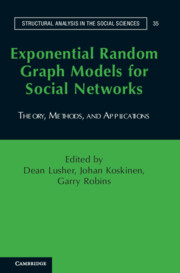1 - Introduction
Published online by Cambridge University Press: 05 April 2013
Summary
Exponential random graph models (ERGMs) are a class of statistical model for social networks. They account for the presence (and absence) of network ties, and so provide a model for network structure. An ERGM models a given network in terms of small local tie-based structures, such as reciprocated ties and triangles. A social network can be thought of as being built of these local patterns of ties, called “network configurations,” which correspond to the parameters in the model. Moreover, these configurations can be considered to arise from local social processes, whereby actors in the network form connections in response to other ties in their social environment. ERGMs are a principled statistical approach to modeling social networks. They are theory driven in that their use requires the researcher to consider the complex, intersecting, and, indeed, potentially competing theoretical reasons why the social ties in the observed network have arisen. For instance, does a given network structure occur due to processes of homophily, reciprocity, transitivity, or a combination of these? By including such parameters together in the one model, a researcher can test these effects one against the other, and so infer the social processes that have built the network. Being a statistical model, an ERGM permits inferences about whether, in our network of interest, there are significantly more (or less) reciprocated ties, or triangles (for instance), than we would expect.
ERGMs are fast becoming recognized as one of the central approaches in analyzing social networks. In this short introductory chapter, we describe the intent of this book, how it is structured, how it may be read, the software resources available, and the knowledge that we expect readers to have before following our text.
Information
- Type
- Chapter
- Information
- Exponential Random Graph Models for Social NetworksTheory, Methods, and Applications, pp. 1 - 6Publisher: Cambridge University PressPrint publication year: 2012
Accessibility standard: Unknown
Why this information is here
This section outlines the accessibility features of this content - including support for screen readers, full keyboard navigation and high-contrast display options. This may not be relevant for you.Accessibility Information
- 6
- Cited by
